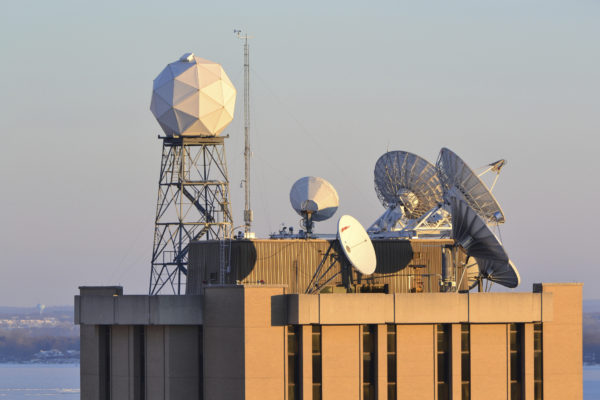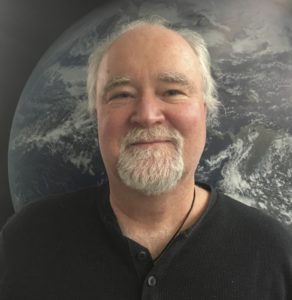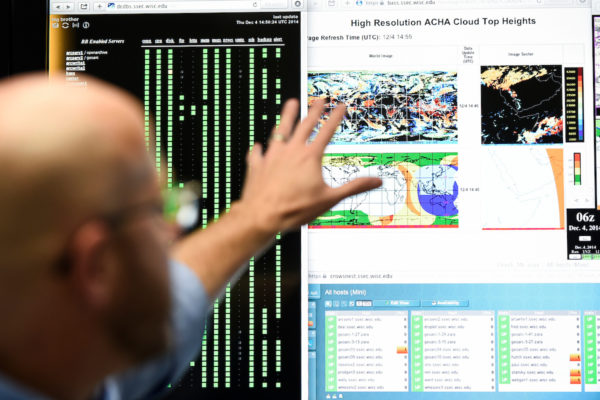SSEC welcomes UW alum, Brad Pierce, to director position

Satellite dishes atop the Atmospheric, Oceanic and Space Sciences Building where the Space Science and Engineering Center is located. Credit: Maciek Smuga-Otto.
Brad Pierce has been named the new director of the Space Science and Engineering Center, following a nationwide search.
Pierce received his Ph.D. and Master of Science from the University of Wisconsin-Madison in meteorology and is a physical scientist at the National Oceanic and Atmospheric Administration (NOAA) within the Advanced Satellite Products Branch on the UW-Madison campus. The Branch is co-located with the Cooperative Institute for Meteorological Satellite Studies (CIMSS) within SSEC and was founded to foster collaboration among NOAA, NASA, and University of Wisconsin research scientists and faculty.

Brad Pierce.
Prior to his tenure at NOAA, Pierce was a senior research scientist within the Atmospheric Sciences Division at the NASA Langley Research Center (LaRC).
Pierce will begin the position as SSEC director on Oct. 1 and report to the Vice Chancellor for Research and Graduate Education.
“I have a long, productive history with SSEC and recognize the important role that the center plays as an international leader in the development and utilization of space based Earth observations,” Pierce says. “I accepted the SSEC director position because of my strong commitment to the continued success of SSEC. I have a deep appreciation for the SSEC culture, which fosters individual creativity and provides institutional support for its principal investigators and scientists.”
The SSEC is integral in the understanding of weather, climate and atmospheric processes worldwide. In addition to developing necessary algorithms necessary to agencies such as the National Weather Service, SSEC designs systems to collect data from stationary and orbiting platforms to support earth and atmospheric science research. Housed within SSEC is the CIMSS, a satellite meteorology research center and the SSEC Data Center. The Data Center holds the world’s largest online, geostationary weather satellite data archive that provides high quality, geophysical data to researchers, but also to industries that are affected by weather.

Satellite weather imagery displayed on computer monitors at the Space Science and Engineering Center Data Center. Credit: Jeff Miller.
“I am honored to be given the opportunity to lead the center forward as the Earth System science community seeks new opportunities under the 2017 National Academy’s Decadal Survey for Earth Science and Applications from Space,” Pierce says. ”I also recognize the critical role that SSEC plays in research at UW-Madison and intend to pursue more interdisciplinary funding opportunities across campus as well as, strengthen post-doctoral recruitment efforts at the center. As director, I will encourage all SSEC research scientists to seek out new research partners on campus through collaborative activities.”
In addition to his scientific skills, Pierce brings a wide breadth of institutional knowledge which emphasizes a balance of research, education and community outreach. He has been an adjunct faculty member within the Department of Atmospheric and Oceanic Sciences (AOS) since 2015 and is actively involved in training the next generation of atmospheric scientists as a graduate student research advisor for both AOS students and CIMSS visiting scholars.
“The combination of Brad’s experience as a federal scientist, his familiarity with the research activities at SSEC and his collaborative work ethic, places him in a position to be an excellent director,” says Norman Drinkwater, interim vice chancellor for research and graduate education. “Over the past two decades, Brad has established collaborations with SSEC research scientists, and AOS, the Chemistry Department and Nelson Institute faculty at UW-Madison. These collaborations have played a critical role in his ability to accomplish long-term research goals that support the national observing system and weather forecasting enterprises. I’m thankful to Steve Ackerman, associate vice chancellor for research in the physical sciences, for his service as interim director of the SSEC.”
###
By Natasha Kassulke, natasha.kassulke@wisc.edu, (608) 219-8042
